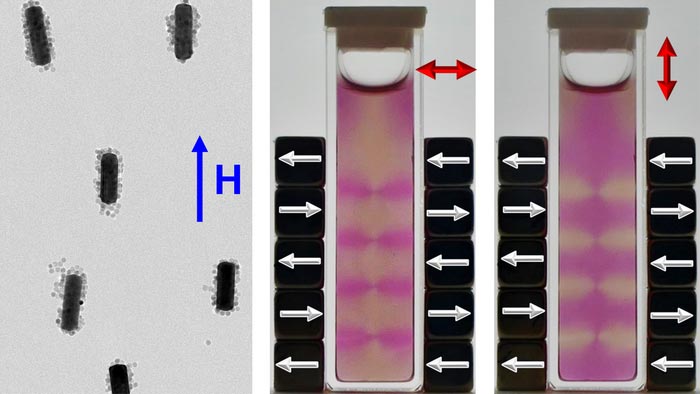

Electron micrograph of gold nanorods overcoated with iron oxide nanoparticles and aligned in a magnetic field. When dispersed in water, gold nanorods overcoated with iron oxide nanoparticles align along the magnetic field pattern generated by arrays of permanent magnets, resulting in polarization-dependent absorption and scattering of light. Double-headed arrows indicate the polarization axis of a linear polarizer through which the sample was photographed.
Credit: Mehedi H. Rizvi
An international team of researchers has demonstrated a technique that allows them to align gold nanorods using magnetic fields, while preserving the underlying optical properties of the gold nanorods.
“Gold nanorods are of interest because they can absorb and scatter specific wavelengths of light, making them attractive for use in applications such as biomedical imaging, sensors, and other technologies,” says Joe Tracy, corresponding author of a paper on the work and a professor of materials science and engineering at North Carolina State University.
It is possible to tune the wavelengths of light absorbed and scattered by engineering the dimensions of the gold nanorods. Magnetically controlling their orientation makes it possible to further control and modulate which wavelengths the nanorods respond to.
“In other words, if you can control the alignment of gold nanorods, you have greater control over their optical properties,” Tracy says. “And using magnetic fields to control that alignment means that you can control the alignment without actually touching the nanorods.”
In their technique, the researchers synthesize separate solutions of gold nanorods and iron oxide nanoparticles. Mixing the solutions drives assembly of the iron oxide nanoparticles onto the surface of the gold nanorods. The resulting “coated” nanorods can then be controlled using a low-strength magnetic field.
“We’ve characterized both what is happening during this process and how well it works,” Tracy says. “We’ve demonstrated that we can bring the nanorods into alignment and that the process does not adversely affect the optical properties of the gold nanorods.”
“In addition, to the best of our knowledge, these nanorods have the smallest aspect ratio of any elongated nanoparticle that has been ‘decorated’ with iron oxide nanoparticles and aligned using magnetic fields,” says Mehedi Rizvi, first author of the paper and a Ph.D. student at NC State.
“In order for this technique to work, we’ve had to optimize many aspects of the system, including the dimensions of the gold nanorods, the size of the iron oxide nanoparticles, and the relative concentrations of both nanorods and nanoparticles in solution,” Rizvi says.
“We are currently in the process of exploring potential applications in imaging based on the multifunctional properties of magnetic-overcoated gold nanorods,” Tracy says.
The paper, “Magnetic Alignment for Plasmonic Control of Gold Nanorods Coated with Iron Oxide Nanoparticles,” is published open access in the journal Advanced Materials. The paper was co-authored by William Crumpler, a former undergraduate at NC State; Ruosong Wang and Jonas Schubert of the Institute for Physical Chemistry and Polymer Physics; Christian Rossner and Andreas Fery of the Institute for Physical Chemistry and Polymer Physics and Technische Universität Dresden; and Amy Oldenburg of the University of North Carolina, Chapel Hill.
The work was done with support from the National Science Foundation, under grants CMMI-1763025 and CBET-1803830; the Alexander von Humboldt Foundation; Deutsche Forschungsgemeinschaft (the German Research Foundation); Fonds der Chemischen Industrie; and by the China Scholarship Council.
-shipman-
Note to Editors: The study abstract follows.
“Magnetic Alignment for Plasmonic Control of Gold Nanorods Coated with Iron Oxide Nanoparticles”
Authors: Mehedi H. Rizvi, William D. Crumpler and Joseph B. Tracy, North Carolina State University; Ruosong Wang and Jonas Schubert, Institute for Physical Chemistry and Polymer Physics; Christian Rossner and Andreas Fery, Institute for Physical Chemistry and Polymer Physics and Technische Universität Dresden; and Amy L. Oldenburg, University of North Carolina, Chapel Hill
Published: June 9, Advanced Materials
Abstract: Plasmonic nanoparticles that can be manipulated with magnetic fields are of interest for advanced optical applications, diagnostics, imaging, and therapy. Alignment of gold nanorods yields strong polarization-dependent extinction, and use of magnetic fields is appealing because they act through space and can be quickly switched. In this work, cationic polyethyleneimine-functionalized superparamagnetic Fe3O4 nanoparticles (NPs) are deposited on the surface of anionic gold nanorods coated with bovine serum albumin. The magnetic gold nanorods (MagGNRs) obtained through mixing maintain the distinct optical properties of plasmonic gold nanorods that are minimally perturbed by the magnetic overcoating. Magnetic alignment of MagGNRs arising from magnetic dipolar interactions on the anisotropic gold nanorod core is comprehensively characterized, including structural characterization and enhancement (suppression) of the longitudinal surface plasmon resonance and suppression (enhancement) of the transverse surface plasmon resonance for light polarized parallel (orthogonal) to the magnetic field. MagGNRs can also be driven in rotating magnetic fields to rotate at frequencies of at least 17 Hz. For suitably large gold nanorods (148 nm long) and Fe3O4 NPs (13.4 nm diameter), significant alignment is possible even in modest (<500 Oe) magnetic fields. An analytical model provides a unified understanding of the magnetic alignment of MagGNRs.
Journal: Advanced Materials
DOI: 10.1002/adma.202203366
Method of Research: Experimental study
Subject of Research: Not applicable
Article Title: Magnetic Alignment for Plasmonic Control of Gold Nanorods Coated with Iron Oxide Nanoparticles
Article Publication Date: 9-Jun-2022












